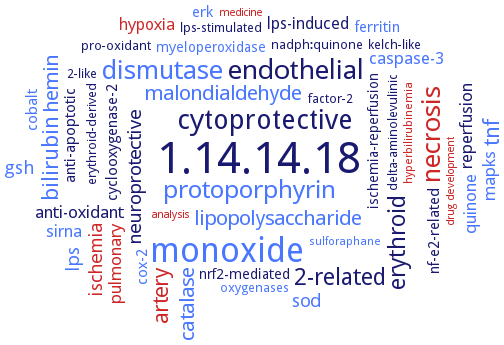Please wait a moment until all data is loaded. This message will disappear when all data is loaded.
Please wait a moment until the data is sorted. This message will disappear when the data is sorted.
21 h treatment with 0.05-0.2 mM docosahexaenoic acid enhances isoform HO-1 expression through transcriptional regulation in human cancer cells. Docosahexaenoic acid induces Bach1 protein degradation, thereby enhancing the transcriptional factor Nrf2-mediated isoform HO-1 gene transcription
-
apoptotic cell supernatants provoke a biphasic up-regulation of HO-1. Although the first phase of HO-1 induction at 6 h is accomplished by apoptotic cell-derived sphingosine-1-phosphate acting via sphingosine-1-phosphate receptor 1, the second wave of HO-1 induction at 24 h is attributed to autocrine signaling of vascular endothelial growth factor A, whose expression and release are facilitated by sphingosine-1-phosphate
-
cell treatment with Salvia plebeia methanolic extract significantly induces the expression of hemeoxygenase-1
-
expression of Hmox1a, Hmox1b and biliverdin reductase b is significantly induced in zebrafish eleutheroembryos in response to pro-oxidants cadmium, hemin and tert-butylhydroquinone
expression of isoform Hmox2a is significantly reduced in male gill samples in response to the 96 hour cadmium exposure
expression of isoforms Hmox1a, Hmox2a and Hmox2b is significantly induced in male liver tissues in response to 96 hour cadmium exposure (20 microM). Hmox2a and Hmox2b are significantly induced in male brain samples
HO-1 activity is upregulated in response to several therapeutic treatments and is implicated in promoting tumour growth
HO-1 expression is chemically induced by cobalt protoporphyrin-IX in HEK293 T-RExTM Nox4 cells resulting in downregulation of NADPH oxidase Nox4 activity
HO-1 expression is induced by cobalt protoporphyrin and andrographolide
HO-1 expression is reduced upon differentiation of cytotrophoblasts into extravillous trophoblasts. Knock down of endogenous HO-1 in BeWo cells using retroviral transduction with a miRNA adapted retroviral vector targeting human HO-1 sequence
-
HO-1 induction after hemoglobin treatment is decreased by about half by MEK inhibitors U0126 and SL327, and is completely prevented by the direct ERK inhibitor FR180204
-
HO-1 induction by hemoglobin. In cultures treated with hemoglobin plus dimethylsulfoxide vehicle for 4 h, which is a time point prior to the onset of neuronal lysis, HO-1 expression is increased 2.2fold over control cultures treated with vehicle only
-
HO-1 is induced by inflammation associated both with an anti-inflammatory response and with mitochondrial biogenesis
HO-1 protein expression is strongly induced 24 h after DOX addition in the HTR-8/SVneo cell line
-
HO1 is induced by several stress conditions, e.g. osmotic and salinity stresses, cadmium exposure, H2O2, and hemin treatments
isoform HO-1 is induced by oxidative stress and cancer
-
lipopolysaccharide downregulates isoform HO-1 in primary human peripheral blood mononuclear cells, CD14+ monocytes, macrophages, dendritic cells, and granulocytes
-
lipopolysaccharide upregulates isoform HO-1 in human monocytic leukemia cell lines. Bach1 is a critical transcriptional repressor of isoform HO-1
-
lipopolysaccharide upregulates isoform HO-1 in in primary murine macrophages
-
low concentration of 4-hydroxy hexenal increases heme oxygenase-1 expression through activation of Nrf2 and antioxidative activity in vascular endothelial cells, overview. The induction is abolished by knockout of Nrf2
-
MsHO1 gene expression and protein level are induced significantly by some pro-oxidant compounds, including hemin and nitric oxide donor sodium nitroprusside
oxidative stress promotes enzyme up-regulation
-
pretreatment with hemin causes up-regulation of enzyme expression
-
pretreatment with hemoglobin induces HO-1 and significantly reduces systemic inflammations associated with plasma concentrations of TNFalpha levels due to intestinal ischemia/reperfusion injury
-
renal HO-1 is induced by angiotensin II, ANG II, when given in high doses
small interfering RNA-mediated knock-down of Nrf-2 significantly inhibits surfactin-induced HO-1 expression. Inhibition of phosphoinositide 3-kinase/Akt and extracellular signal-regulated kinase significantly decreased surfactin-induced HO-1 expression, mechanism of surfactin, overview
-
surfactin, a cyclic lipopeptide produced by Bacillus subtilis, induces HO-1 mRNA and protein expression via activation of Nrf2, and PI3K/Akt and ERK, mechanism of surfactin, overview. Nrf-2 is a redox-sensitive basic-leucine zipper transcription factor
-
systemic enzyme levels are dramatically increased in individuals with active pulmonary and extra-pulmonary tuberculosis and particularly those with bilateral lung lesions and elevated bacillary loads in sputum
-
transcripts can be differentially induced by hemin, paraquat, and NaCl treatments
HO-1 is induced by inflammation associated both with an anti-inflammatory response and with mitochondrial biogenesis

-
HO-1 is induced by inflammation associated both with an anti-inflammatory response and with mitochondrial biogenesis
-
-
renal HO-1 is induced by angiotensin II, ANG II, when given in high doses

-
renal HO-1 is induced by angiotensin II, ANG II, when given in high doses
-
-




 results (
results ( results (
results ( top
top





